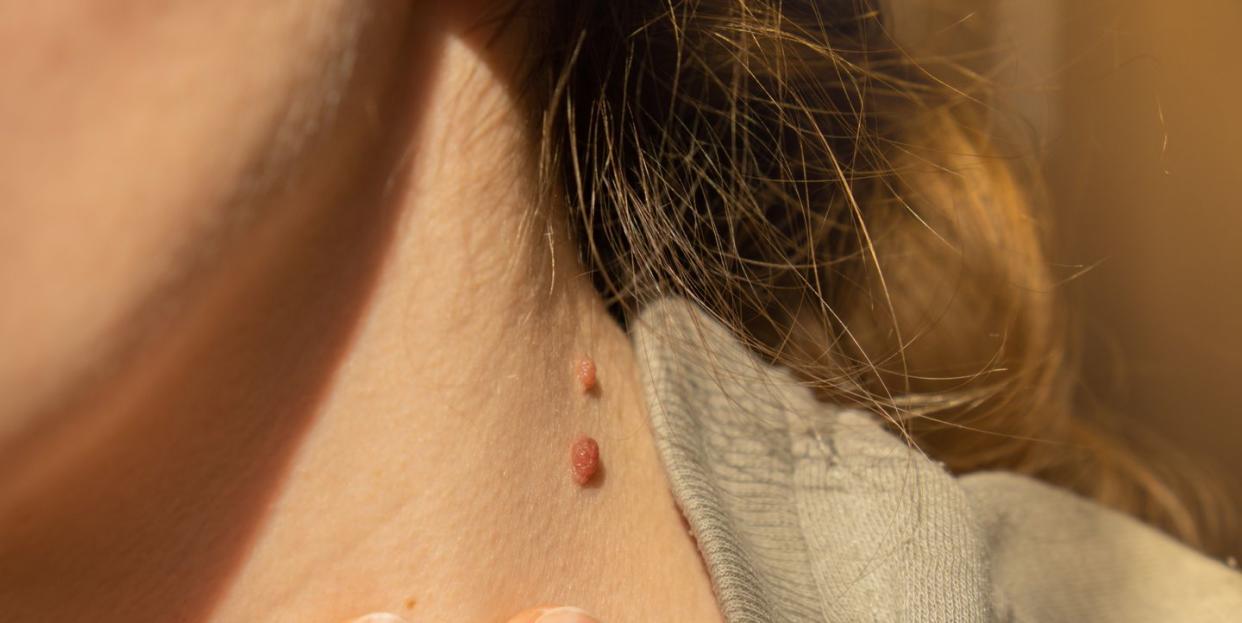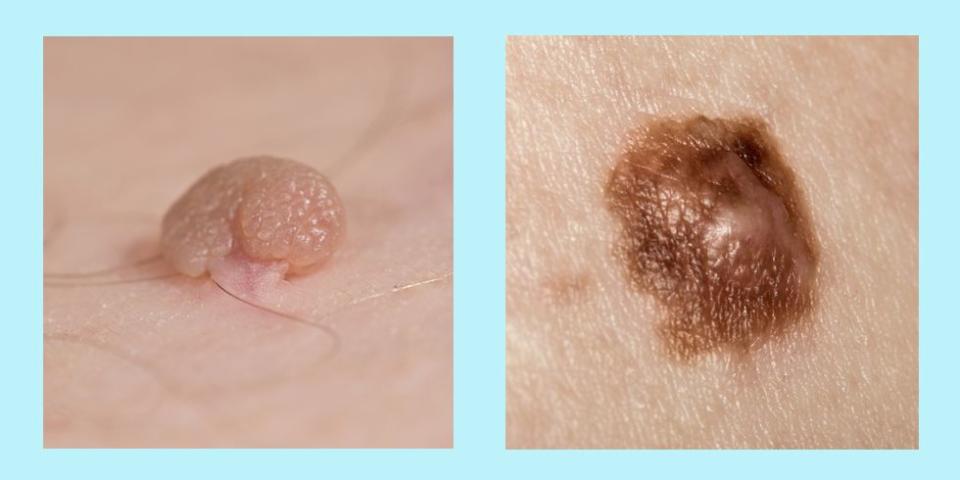Experts Explain Why You Should Never Try to Remove a Skin Tag Yourself

From adult acne to regular skin cancer checks, a yearly visit to the dermatologist can do wonders for your skin’s health. Most of the time, skin spots are nothing to be alarmed about, but a doctor can work with you to feel worry-free and find ways to deal with particularly irksome skin issues. One of the most common skin problems are little, fleshy growths called skin tags. Though they’re usually harmless, they can make you feel self-conscious. We chatted with experts to see how to get rid of skin tags and everything you need to know when they start to pop up.
What is a skin tag, anyway?
Skin tags are small, soft growths on the skin that usually form on the neck, underarms, groin, or eyelids, but they can happen anywhere, explains Allison Larson, M.D., board-certified dermatologist with MedStar. She notes that most people get skin tags at some point in their life.
“Skin tags are benign skin growths due to an ‘outpouching’ of the skin that is connected to the underlying skin,” says Sejal Shah, M.D., a board-certified dermatologist in New York. The result is a fleshy little growth that protrudes from your skin. Unlike a pimple or a cyst, which causes a raised area of skin, skin tags are attached to the surface of the skin via a thin stalk, giving them a kind of “wiggly,” tag-like appearance.
Skin tags (which are medically called “acrochordons,” if you want to get technical) are small but they can be pesky. The tags, which are typically the color of the person's skin or a touch darker, are usually two to five millimeters in size, though they can sometimes get bigger, according to the American Osteopathic College of Dermatology (AOCD). They often appear in clusters.
Generally, these growths are totally harmless, says Dr. Shah, but they can easily become irritated and inflamed. People frequently complain about skin tags getting caught on clothing or jewelry.
How to get rid of skin tags
There are two main reasons you may want to remove a skin tag. “If a tag is large, painful, bleeding, or getting in the way with daily activities, you may be able to get the tag removed,” says Joshua Zeichner, MD, a board-certified dermatologist and the director of cosmetic and clinical research in dermatology at Mount Sinai Hospital in New York. However, plenty of people also get them removed simply because they don’t like the way they look, but Dr. Larson notes many insurance companies won’t cover skin tag removal for cosmetic purposes.
No matter how big or small, skin tag removal means a trip to the derm. It’s important to have your doctor take a look at your skin tag before removing it to ensure the growth doesn’t have anything wrong with it.
“If you’re considering having them removed, have them checked first to make sure there isn’t anything worrisome about them,” she says.
There are three ways a board-certified dermatologist can remove a skin tag, explains Dr. Shah: “cryosurgery, which involves removing the tag by freezing the skin with liquid nitrogen; cautery, which involves burning off or destroying the tissue with heat; or cutting it off with medical scissors.” While none of these options for skin tag removal are exactly pleasant, they are pretty effective and easy—afterward all you’ll need is a Band-Aid.
Ife Rodney, M.D., F.A.A.D., dermatologist and founder of Eternal Dermatology + Aesthetics adds that the skin is usually numbed before treatment, so it shouldn’t be a particularly uncomfortable procedure.
Home remedies for skin tags removal
You may be tempted to just yank or snip them off—but that’s not a great idea. “I caution people not to remove skin tags at home because they can get infected and they tend to bleed a lot, which you may not be able to control yourself at home,” says Dr. Zeichner.
On top of that, you’re more likely to cause a scar or risk only removing part of the skin tag, which would mean going to see the dermatologist for another procedure anyway.
Some people will use dental floss to tie around the skin tag and remove them or over-the-counter wart and skin-tag removal creams and cryotherapy kits that freeze the tag, but Dr. Rodney suggests avoiding at-home remedies at all costs. She warns that these can cause infections or you may risk confusing a skin tag for something that really needs to be seen by a doctor.
Dr. Larson adds that these over-the-counter remedies often work by irritating the bottom of the skin tag, which can lead to a lot of inflammation, itching, pain, and discoloration.
What causes skin tags?
Dermatologists don’t really know what causes skin tags, but there are a few theories. What makes them annoying is that they typically grow in folds of skin or areas where there tends to be a lot of friction—think: armpits, neck, and groin. That might be why you see them pop up in skin folds, says Dr. Shah.
Dr. Larson adds that though we don’t know for sure what causes them, there seem to be common risk factors for people who develop skin tags like family history or genetics, older age, higher body weight, or hormonal changes, like pregnancy.
Age is a major factor in skin tags, says Dr. Rodney. People over 40 are more likely to develop them, and that increases even more over the age of 60.
Skin tags are also more common in people who have diabetes, adds Dr. Zeichner. Because of this, Dr. Larson adds your dermatologist may choose to test you for diabetes if you have a lot of skin tags.
Though the connection isn’t confirmed, according to the American Academy of Dermatology, skin tags may be tied to too much insulin in the blood, and therefore a warning sign of diabetes. “There is also a likely a genetic component because they tend to run in families,” says Dr. Zeichner.
Can you prevent getting skin tags?
Unfortunately, there’s not much you can do beyond staying healthy. “Try to live a healthy life with a well-balanced diet, exercise, and keep your weight in check,” says Dr. Zeichner.
To keep an existing skin tag from getting irritated, try to reduce any friction there as much as possible.
Can skin tags be cancerous?

Like any spot on your skin, dermatologists recommend keeping an eye on it. “Rarely a skin tag might not be a skin tag at all, but rather a skin cancer,” says Dr. Zeichner. “No matter what, if you have a new or changing spot, make sure to get it checked out. This includes rapid growth, changing color, or bleeding.”
Dr. Larson adds that skin tags are generally a cosmetic issue and though they can point to other issues (like diabetes), they rarely point to cancer.
If your skin tag is painful, itchy, or starts to seem more like a sore, that’s also cause for getting an expert opinion. The bottom line? “If you are not sure if it is a skin tag,” says Dr. Shah, “it’s best to have it evaluated.”
You Might Also Like

